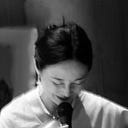On Asako Takami's 14th spiritual birthday.
“Why do I dance?”
When a dancer asks to her/himself, it leads to the fundamental questions about life. “Who am I?” “What do I like?” “Why have I come here?” “What gift do I carry to the next life time?”
Asako Takami (1960-2007) who opened the door to Odissi dance for me, wrote clearly in her young days.
Dance is something I learn until the end of my life. It is something connected to myself deeply. It is more important than my occupation. My guruji, Kelucharan Mohapatra tried to attain the absolute beauty throughout his life. His dance was the eternal essence of beauty… I would like to take this path myself, too. Costumes, ornaments, elaborated lighting, large scaled stages, etc. — — All of those, I do not need. What I aim is the “true art”, not the stage performing arts.
(From Asako’s notes in her 20’s, when she visited Kelucharan guruji. Guruji was 62 years old.)
The Indian classical dance is practiced as performing arts. So, stage entertainments reside near. However, there is a thin but clear layer between them. Indian classical dance was offered to deities in temples. That was a prototype of this dance form.
The late Asako was reunited with the Bharatanatyam guru Shyamala Mohanraj. Shamala ji visited the San Francisco Bay Area and offered a performance in May, 2007. Sri Lankan dance guru Shamala ji was one of the senior disciples of Balasaraswati. Shamala ji talks about the importance of spirituality in dance in her documentary film . In olden days, gurus taught dance students to be calm and focus on her/his offering to deities before they go on stage. Guru Shyamala Mohanraj passed away on July 14, 2015, at age 74.
The small stage was decorated by flowers and hangings at the both sides. After the opening music of Lord Ganapati, Shyamala in a green blouse and yellow saree appeared from the drape. Her eyes were fixed towards the audience opened gazing straight forward.
Suddenly, her face was loosened and she smiled slowly softly. Was it right to say she smiled? Her smile was not like making a fake smile or trying to impress people and such at all. It was noble and compassionate.
“Welcome..”
As if she was the goddess, inviting us to the world in which we were about to enter. Now her smile disappeared. Very subtly her neck started swinging left to right synchronizing with the rhythm. It was hardly recognizable if she was moving or not moving. However, I could see her dance had started.
One item by another item, as if reading an anthology of short tales, the stories begun. Her slender eloquent body, long arms.. Her face was rather long with high cheek bones. I think she must have been in her 60’s. … but as she changed her facial expressions, her age disappeared. With her sparkling eyes, she looked like a young girl.
….. That is dance. A dancer’s body transcends time and space to when she/he actually learned that dance piece. I have seen this many times.
Nevertheless, it is the dancer’s “presence” itself. Whether or not a dancer is young or old, pretty, fat or slim, on a large stage, good lighting, live music or recorded music,…. These completely do not matter. A touching performance transcends all of that. I always think so.
It was in 1998 or 99, in Chennai, I was learning dance from Shyamala at her house. Believe or not, I learned “Krishna ni begane”. It was said that she rarely taught this item to anyone. This song was my most favorite song of Balasaraswati and it was one of her best songs. I loved Balasaraswati singing this song especially. It was the only item I wanted learn from Shyamala if she felt like teaching me. I appreciate Mukund’s grandmother, smt Savitri Rajan and Mukund’s family.
I guess since I was not a Bharatanatyam dancer, and she may have thought that it would not harm anything if she taught this Japanese student. Whenever I visited her and saluted to her feet, I felt she was channeling to “Bala”. Her anjali was so beautiful because she let the anjali be manifested in its own significance. It was not only the exterior appearance. Her anjali was united with her soul and it flowed out from inside.
(Asako’s note, dated on May 13, 2007. She passed away on November 3, same year.)
Asako’s voice echos inside me whenever I dance.
Haruko Tanaka
(photo: Toshiko Takeuchi)
